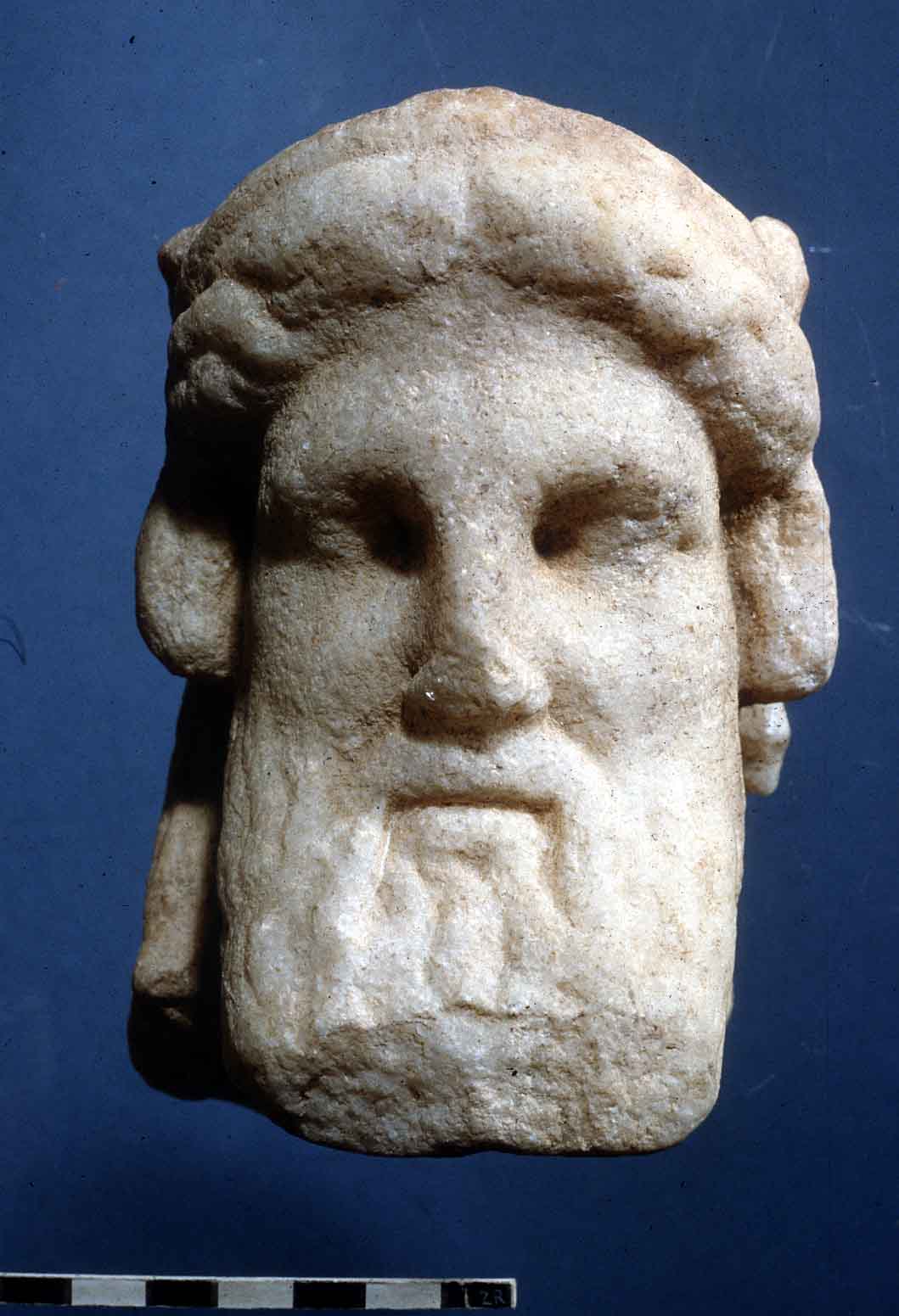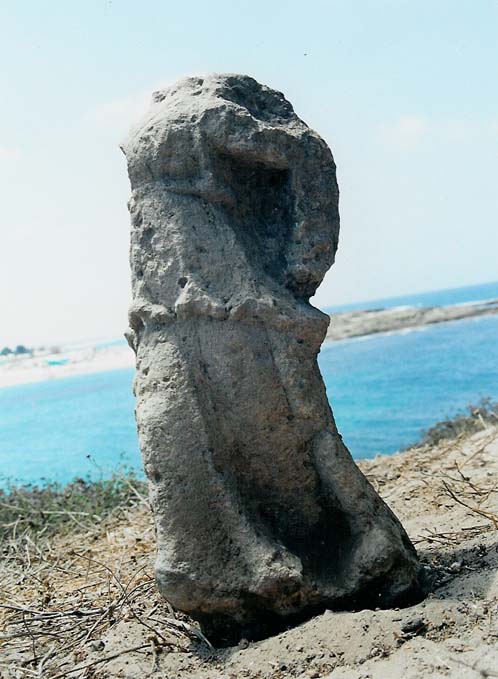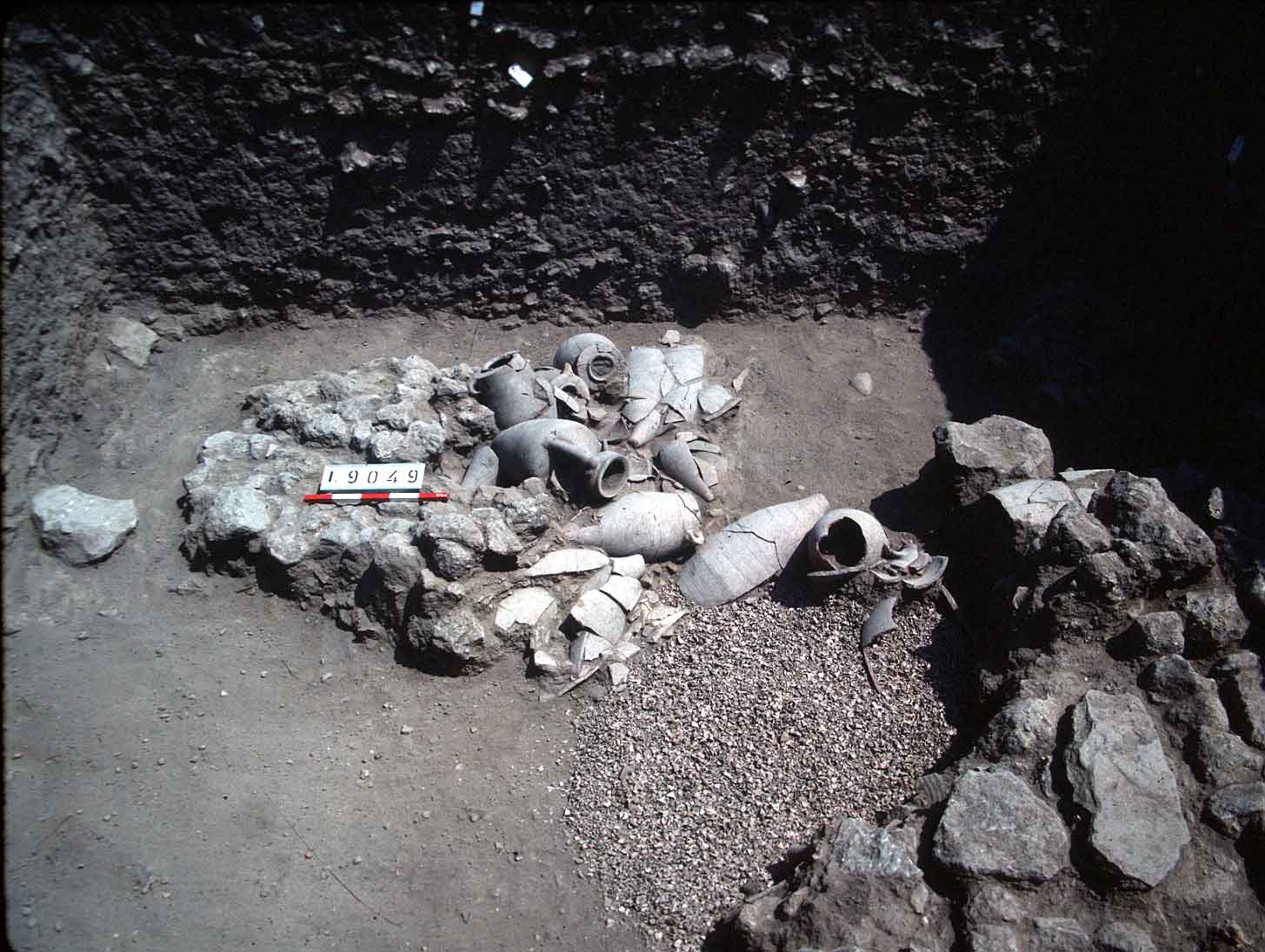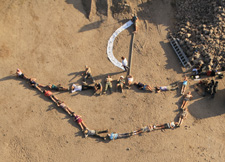Hellenistic period
Historical References
The Hellenistic era in Israel is divided into four historical phase:. The conquest of Palestine by Alexander the Great and its aftermath (332-296 B.C.E.), Ptolemaic rule (296-201 B.C.E.), Seleucid rule (200-104 B.C.E.), and Hasmonean rule (104-64/3 B.C.E.). Josephus describes Hellenistic Dor as "a fortress difficult to take" (Antiquities XIII, 7: 20). Twice during this period the city was besieged unsuccessfully, first by Antiochus the Great in 219 (Polybius History V.66) and then by Antiochus VII Sidetes and Simon the Hasmonean in 138/7 B.C.E. in an attempt to oust Tryphon - a pretender to the Seleucid throne (1 Maccabees 15: 10-14; 25-26, 37, Joesphus, Antiquities XIII, 7:2 and Wars I, 2: 2). Sling bullets made for Tryphon's forces were found outside the city gates area.
 The tyrant Zoilos ruled Dor and its neighbor
Straton's Tower (later to become Roman Caesarea) in the late second
century B.C.E. Alexander Jannaeus (104-78 B.C.E.) may have
wrestled control of these cities away from Zoilos around
100 B.C.E. The city was under Hasmonean rule until the
conclusion of the Hellenistic period in 64/3 BCE when
Dor is included in a list of cities granted autonomy
by Pompeius and placed under the authority of the Roman
governor (Josephus, Antiquities XIV 4:4).
The tyrant Zoilos ruled Dor and its neighbor
Straton's Tower (later to become Roman Caesarea) in the late second
century B.C.E. Alexander Jannaeus (104-78 B.C.E.) may have
wrestled control of these cities away from Zoilos around
100 B.C.E. The city was under Hasmonean rule until the
conclusion of the Hellenistic period in 64/3 BCE when
Dor is included in a list of cities granted autonomy
by Pompeius and placed under the authority of the Roman
governor (Josephus, Antiquities XIV 4:4).
Other Greek sources state only that Dor was a small city with maritime significance adjacent to Straton's Tower (Apollodoros, Artemidoros of Ephesos, Alexander Ephesius ap. Steph. Byz. s.v. "Doros").
 Archaeological explorations have revealed extensive
evidence of the Hellenistic city. In the eastern
part of the mound are remains of the well-fortified
city wall, workshops, and houses running along a
north-south street. The east-west street runs from
the city gate to public buildings overlooking one
of the three natural harbors. The primary economic
activity of Hellenistic Dor was centered around
these harbors: trade, ship building, fishing, and
the harvesting of murex for the manufacture of purple dye.
Archaeological explorations have revealed extensive
evidence of the Hellenistic city. In the eastern
part of the mound are remains of the well-fortified
city wall, workshops, and houses running along a
north-south street. The east-west street runs from
the city gate to public buildings overlooking one
of the three natural harbors. The primary economic
activity of Hellenistic Dor was centered around
these harbors: trade, ship building, fishing, and
the harvesting of murex for the manufacture of purple dye.
Other finds speak to the mixed Phoenician-Greek character of the city. Greek and Greek-influenced material includes imported table-ware, wine amphorae, figurines, a marble "herm," a fine Dionysiac mosaic, and an akroterion (roof sculpture) in the form of the goddess Nike. The Greek language appears on lead weights, catapult stones, ostraka and in signatures on pottery vessels. The continuing Phoenician character of the population is attested inter alia by the persistence of ancient Phoenician building traditions and by evidence of the textile-dyeing industry, including quantities of loom weights, spindle whorls, and dyeing installations. The sling bullet of Tryphon is inscribed both in Greek and Phoenician, showing that local behaviors persisted even as the population came into increasing contact with Greeks and Hellenic culture.
Archaeological results
Area A
Local phases 2-4: Section of the city wall, including a tower. Two partially-excavated insulae on either side of Persian-Roman street I (see plan) leading from area B to area C.
Area B2
Local phases 3-4: In the Hellenistic period there was no 'piazza', though both street I and the decumanus (main east-west street) date back at least to this era (see plan). South of the gate (and under the Roman peristyle house) the city-wall turned east and then south again, so as to include within the fortifications a massive structure - probably a gate-bastion. A concentration of several dozens catapult stones of various diameters was found here.
Area C
The Hellenistic period (phases 2-4) is the best preserved one in area C. The central Hellenistic Insula C0 can still be seen on site. It consists of several residential units built with fine ashlar masonry on the west side of the Persian-Roman street. A long stretch of the city wall, probably built during the Ptolemaic period (third century B.C.E.), and an additional square tower were excavated east of Insula C1.
Area D1
 In the earlier Hellenistic phase (phase 4), the area is dominated by two connected structures we refer to as the Monumental Hellenistic Complex. The smaller structure is in the west and has four long rooms oriented north-south with a fifth, perpendicular room running along the north side. Its northeast corner abuts a 26-meter long southern wall of a larger structure (that extends into Areas D2 and D4). Altogether this complex, with its large building and western "wing," once occupied at minimum some 800 square meters of the southern part of the tell, making it one of the larger Hellenistic structures known in ancient Palestine. In the later Hellenistic period, the complex was built over with thinner walls. These are built in a technique (so-called "pseudo a-telaio") found also in the Punic west.
In the earlier Hellenistic phase (phase 4), the area is dominated by two connected structures we refer to as the Monumental Hellenistic Complex. The smaller structure is in the west and has four long rooms oriented north-south with a fifth, perpendicular room running along the north side. Its northeast corner abuts a 26-meter long southern wall of a larger structure (that extends into Areas D2 and D4). Altogether this complex, with its large building and western "wing," once occupied at minimum some 800 square meters of the southern part of the tell, making it one of the larger Hellenistic structures known in ancient Palestine. In the later Hellenistic period, the complex was built over with thinner walls. These are built in a technique (so-called "pseudo a-telaio") found also in the Punic west.
An opus vermiculatum mosaic of the mask-an-garland type,
arguably the finest piece of
Hellenistic art ever found in the country, may have belonged with this
building or an adjacent one. It was recovered from a Roman pit
in the area. In another pit, a statue of Nike (victory) was found.
Area D2
There is a marked change in the character of area D2 within this period. Whereas in the Persian period most of the area was comprised of buildings with long and narrow halls - probably harbor store-houses - during the Hellenistic period, the area is mostly residential. On the northern edge of the northern insula is the Monumental Hellenistic Complex (see also Areas D2 and D4). The basic divisions (insulae and streets) of area D2 are similar in the subsequent Roman period.
Area F
 Remains dating to the Late Hellenistic period (phase 3) were found buried underneath the temple podium. These consist of a large olive press with two beam-and-weight presses. Earlier Hellenistic remains, as well as Persian ones, were cut by the Roman foundations.
Remains dating to the Late Hellenistic period (phase 3) were found buried underneath the temple podium. These consist of a large olive press with two beam-and-weight presses. Earlier Hellenistic remains, as well as Persian ones, were cut by the Roman foundations.
Area G
Local phases 3-4:
The open, possibly public nature of this part of town is evident in the
Hellenistic and
Persian periods too. The center of the area
seems to have been an open space throughout these eras and to the east
and south of it were what appear to be residential insulae.
To the west and north, on the other hand, were found massive ashlar
foundations of the facades of large public structures.
Most of the buildings themselves, though, are outside the excavated
area.
